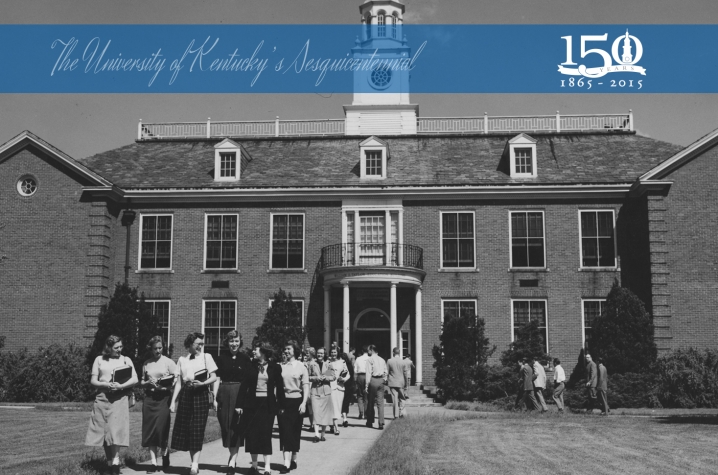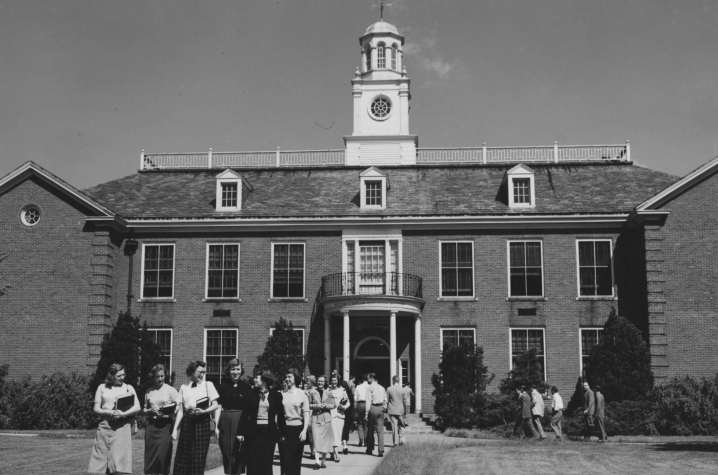UK College of Education: 92 Years of Fostering the Next Generation
LEXINGTON, Ky. (Feb. 25, 2015) — At the foundation of our society, the stimulant for a successful future and a catalyst of change is education — a constant cycle of learning and leading. Long committed to shaping the next generation of educators and students through academia, research and outreach, the University of Kentucky College of Education continues its mission set nearly 92 years ago.
Even before the College of Education was established, the university, named the Agriculture and Mechanical College of Kentucky University at the time, placed a priority on educating prospective teachers. The Normal School was founded 135 years ago, offering courses in the theory and practice of teaching, and general subject areas. Graduates of the school received a diploma recognizing their efforts, but no degree until the Bachelor of Pedagogy degree was conferred in 1893.
In 1908, the establishment of the Department of Education in the College of Arts and Science (now College of Arts and Sciences) replaced the Normal School, offering teaching certificates and two new degrees. Ten years later, the legacy of impacting teachers and students through hands-on training and community engagement began with a high school located on campus.
The University School, also known as the Model School, was established in 1918 and joined the Department of Education in 1919. The high school was a four-year secondary institution, eventually housed in the Taylor Education Building, with a three part mission: educating Fayette County students, training UK education students for a future in teaching, and acting as an educational laboratory. At a time when many students in the Commonwealth still attended one-room schools, educators across Kentucky visited the school to see the innovative approach.
Although the Department of Education continued to fulfill its purpose at the university, the need to accommodate more education students became apparent. In a period of expansion for the university, and when the legislature was not impressed with the quality of education and the number of teachers in Kentucky schools, reports and surveys recommended UK transform the department into a full-fledged college.
On May 22, 1923, the UK Board of Trustees approved President Frank L. McVey’s request to establish the College of Education and to name William S. Taylor as dean. With these advancements, the “state university” soon became the leader in not only preparing educators and impacting students across Kentucky, but also playing a key role in educational policy for the Commonwealth.
Taylor, a Kentucky native, earned his bachelor’s at UK and worked for the Federal Vocational Education Board and Pennsylvania’s Department of Education before returning to UK as dean. Credited with transforming the education curriculum at UK and the university’s role in the state, he served as dean until his death in 1949. The Taylor Education Building, erected in 1930 and named after the dean, still stands today where students learn the skill sets needed to instruct in their own classrooms.
After establishing the college and bringing in Dean Taylor, McVey continued to impact the university and college in significant ways, including implementing doctoral degrees at UK in 1926. He was careful in selecting which departments offered the advanced degrees, and in 1929, a College of Education student earned the first doctoral degree at UK.
After the passing of Dean Taylor, another educator with a lasting legacy followed in his footsteps. Frank G. Dickey assumed the role of dean in 1950. During his tenure as dean, all graduate students were required to take the National Teacher's Examination prior to receiving their graduate degrees. By the contents of Dickey's annual report and comments from the director of student teaching, 1953 seemed to be a year of growth in numbers and influence for the College of Education.
In his report, Dickey noted more students were preparing for elementary school teaching, where educators were needed most at that time, and the faculty's contributions to the development of the Minimum Foundation Program in Kentucky, a financial reform measure. The director of student teaching reported that they had received requests for more than 3,000 teachers, but only had 288 available. Because of the growing requests, many were being placed in off-campus schools for the first time.
In 1956, Dickey was appointed president of UK at age 38, the youngest man ever to attain that position, and Lyman V. Ginger was named the third dean of the college. By this time, 1,946 undergraduates and 1,641 graduate students had been prepared as educators by the College of Education.
Ginger, former director of the University School and dean of the College of Adult and Extension Education, not only led the college, but also became president of the National Education Association, traveling across the world to speak on democratic education principles. As dean, Ginger increased enrollment, expanded services in the college and ingrained its mission. In an article titled, "Philosophy of the College of Education," he once wrote:
"The College of Education is devoted to the advancement of public education in Kentucky; in such respect, it has a special leadership obligation as part of the University which the state has made the apex of its educational program. It has a threefold responsibility: teaching, research, and service, with the improvement of teaching its main goal."
With the college's rapid expansion after World War II, the University School found it difficult to fulfill its primary purpose of training College of Education students. In 1962, the school closed and the college instead expanded its teacher preparation programs to include placements in area schools.
The next several years marked a focus on infrastructure with construction completed on the Seaton Center, later housing the Department of Health, Physical Education and Recreation (the forerunner to the Department of Kinesiology and Health Promotion), and Dickey Hall, named in honor of Frank G. Dickey.
After George W. Denemark became dean in 1967, the organization of the college was also transformed. Eight departments of instruction were established in the late '60s:
· Administration and supervision
· Curriculum and instruction
· Educational psychology and counseling
· Health, physical education and recreation
· Higher and adult education
· Social and philosophical studies in education
· Special education
· Vocational education
During Dean Denemark's tenure, field service by faculty members and students continued to expand, including work to promote a concept of diagnostic instruction with 21 school districts in northern Kentucky, as well as the establishment of the Louisville Urban Education Center, aimed at the study and improvement of urban education. In another initiative, students worked with inner-city pre-school children in activities linked with viewing "Sesame Street."
From 1985-1990, while Edgar L. Sagan served as dean, the College of Education was instrumental in the development of the Kentucky Beginning Teacher Internship Program, joined the Holmes Group, and became the headquarters for the Consortium for Overseas Student Teaching.
J. John Harris III became the sixth dean of the College of Education, and the first African-American college dean at the university, in 1990. During his time as dean, the Central Kentucky Educational Cooperative located its headquarters in the college, and the Kentucky Institute on Education Reform was established within the college. Harris followed his term as dean with a professorship in the college's Department of Educational Leadership Studies.
In 1995, Shirley C. Raines served as dean, and within two years two Fayette County public schools were designated professional development schools for the college — Winburn Middle School and Squires Elementary.
The first several years of the 20th century involved Edgar L. Sagan stepping in as interim dean for one year, James G. Cibulka as dean from 2002-2008, and Rosetta F. Sandidge as interim dean from 2008-2009. Sandidge is an associate professor and the associate dean for academic programs, accreditation, and planning in the college.
Since 2009, Mary John O'Hair has led the college into the next generation of teaching and learning. With a focus on distance education, international experience and partnerships throughout the state and nation, Dean O'Hair has continued to leverage the skills of the College of Education faculty, staff and students to meet the needs of Kentuckians and those beyond the Commonwealth.
Today, 1,989 undergraduates and approximately 1,000 graduate students are enrolled in the College of Education. Seven departments are housed in the college, including the departments of curriculum and instruction; early childhood, special education and rehabilitation counseling; educational leadership studies; educational policy studies and evaluation; kinesiology and health promotion; educational, school and counseling psychology; and STEM education.
Its success in preparing first-class educators and influencing education framework and policies lies in its commitment to not only academia, but in hands-on research with more than a dozen centers, clinics and labs; in training College of Education students in its many programs serving the community; and in offering guidance and leadership to educators across Kentucky.
This year alone, a new Early Childhood Lab (ECL) opened, more than double the size of the former location, and the college and university began negotiations with Fayette County Public Schools to move the STEAM Academy to campus.
With a three-part mission, the ECL provides high-quality early care and education to the Lexington community; serves as a training site for pre-service teachers; and is used as a research site for child development and early childhood education.
Opened in 2013, the STEAM (science, technology, engineering, arts and mathematics) Academy is an innovative partnership between UK and Fayette County Public Schools. The high school offers students access to UK faculty, staff, students and resources. Relocating the academy to campus will enhance the College of Education's research and student training, as well as STEAM students' preparation for college.
While the mission of the college has never wavered, educational needs in the Commonwealth, country and at UK are ever-evolving. Driven by history and for posterity, the college continues to impact and innovate.
In 1918, a revolutionary model brought high school students to campus, and placed the College of Education students and faculty at the heart of their calling. In 2015, the college is embarking yet again on a mission to transform education with another high school located on campus, as well as its many initiatives founded on the same notions of that first University School — fostering the next generation of students and educators.
MEDIA CONTACT: Whitney Harder, 859-323-2396, whitney.harder@uky.edu






